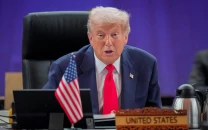Half steps on Guantanamo
While Guantanamo may be closed down, facility based on same principles may open in US to try future terror suspects.

The writer holds a Juris Doctorate and LL.M specialising in international law and is a member on the board of directors for Americans for Justice and Democracy in Pakistan. He tweets @warishusain
However, in 2009, Democrats in Congress had attempted to battle with the Republicans to begin closing Guantanamo and received little assistance from the president. Jim Moran, a Democrat, who was involved in the push to close the prison stated that the president “left all of us twisting in the wind”. He did this through a White House directive that forbade the Department of Justice or White House officials from briefing or meeting with Democrats to assist in their attempts to close Guantanamo.
Insiders claimed that leading officials in the White House did not assist the Congressmen because they did not believe it was worth the “political capital” it would cost to close the prison. While some conservative members in Congress have frustrated efforts to close the Bay based on “national security” concerns, there were some who were willing to take up the fight to close Guantanamo. Therefore, when President Obama attempts to shift blame on legislators for keeping Guantanamo open, he should recall his own refusal to assist Congressmen in their attempts four years ago.
Whatever the reason for the president’s newfound urgency, the Obama Administration has indulged in acts, such as force-feeding the striking inmates, which may seem like a humanitarian act to save the inmates’ lives. However, Scott Horton, writing for Harpers, explained that the force-feeding procedures being used in Guantanamo are based on torture techniques used by the CIA. In fact, both the United Nations and the World Medical Association categorise forced feeding as torture and a violation of international law. Yet, the continued forced-feeding is a less disturbing policy than the defence of military commissions by President Obama, calling for closure of Guantanamo. He stated that he would ask the Department of Defence to “designate a site in the United States where we can hold military commissions”. This means that while Guantanamo may be closed down, a facility based on the same principles will be opened in the US to try future terrorism suspects through military commissions rather than regular civilian courts.
Even more frightening, President Obama did not have an answer for the dozens of inmates at Guantanamo who cannot be charged with any crime because there is insufficient evidence against them. In his speech, he seemed to leave the issue of indefinite detention for some suspects up to future debate without advocating for either side, even though indefinite detention without trial is strictly prohibited by both US and international law.
The one positive step that the administration seems to have taken is to remove its prior moratorium on transferring detainees to Yemen. Though most of the detainees have Yemeni citizenship, there are others who come from other countries that could torture them if repatriated, which poses another problem for the US in its attempts to close Guantanamo.
While opening up the discussion on closing Guantanamo is a positive change in the Obama Administration’s otherwise secretive governance style, the devil will be in the details. The issues of indefinite detention and the continued use of military trials for terrorism suspects must also be discussed formally. Without a plan to normalise criminal procedures for prosecuting terrorism suspects in civilian courts, the injustices of Guantanamo may be carried out in other detention sites on US soil in the future.
Published in The Express Tribune, June 14th, 2013.
Like Opinion & Editorial on Facebook, follow @ETOpEd on Twitter to receive all updates on all our daily pieces.



















COMMENTS
Comments are moderated and generally will be posted if they are on-topic and not abusive.
For more information, please see our Comments FAQ